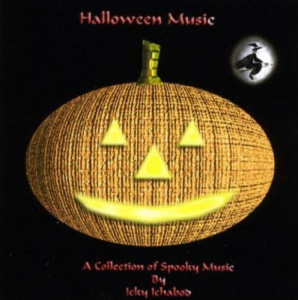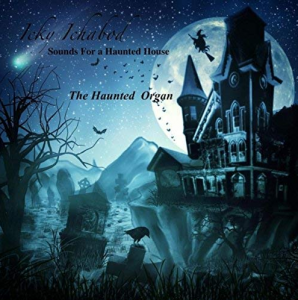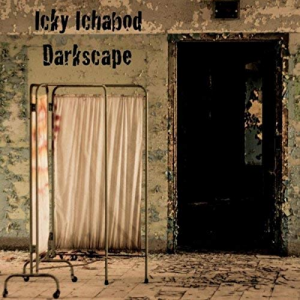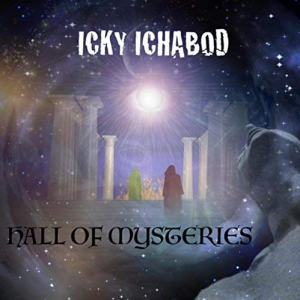Icky Ichabod
Official Site
Halloween Music, self-release 2009
The Haunted Organ, self-release 2016
Darkscape, self-release 2016
Hall of Mysteries, self-release 2016
Kevin J Gardner created his “Icky Ichabod” identity in 2009 but had been involved in music long before then. His compositions have been heard in numerous radio spots, films and television shows. But being Icky Ichabod let him stretch his legs. Not only could he create spooky music for Halloween and haunted houses, but he also released the book Paranormal Poems in 2014! So let’s start at the very beginning with his debut 2009 release, Halloween Music.
“Samhain” starts the album off with low piano work. Creepy light backing tones with touches of percussion soon join in. While the piano work changes things up, the rest turns into the very definition of “cacophony.” But then it dies down until only soft, squeaking creaks and gusts of wind are left with the piano. Things pick up for a more mild version of the cacophony from earlier. Only this time some strange synth tones join in as well before the addition of scattered light notes lead to a great closing fade. Chimes reminiscent of a music box are combined with a soft, pounding beat in “Skeleton Bones.” Some whispering effects appear at one point and snappy percussion foreshadows the change in chimes. Odd, somewhat sci-fi tones get a soft solo before chimes and otherworldly effects take over. Soft drums and a coughing laugh can be heard too. Although the snaps vaguely suggest rattling bones, the other parts make it possible to work in a haunted nursery. You just need to make sure you have a clown doll with an arm positioned like it’s coughing and a toy robot to match up with certain parts of the track. “The Thinning Veil” offers moody chimes and backing drum beat you can dance to! There are brief recurring appearances by breathy wails and a fuzzy drum machine. Chirping and an otherworldly effect like passing through another dimension make repeated appearances throughout the track. They’re also joined by chimes and snippets of clinking noises. It’s just what your vortex tunnel needs! “Ghost Ship” makes interesting use of synth effects and multiple pianos, along with the occasional drum beat. A tambourine briefly joins in to pick things up while cymbals and other percussion effects join for a spell. The tambourine then returns with a vengeance and new piano variations join in to create the feeling of distant lands. The complete feel of the track creates the feel of a ship in rolling waves without using any sound effects. It appropriately dies down and fades out like a ghost. One use for this track would be to play it in a room decorated to look like the inside of a pirate ship. But others might prefer to construct a prop with dead pirates hanging from it and play the track soft enough so people only hear it when they get close to the prop. Cymbals, drums, piano work and a backing beat take us into “Ripper.” Very fuzzy tones join in, along with some frantic piano work. This gives the track a sense of fleeing (especially when things up pick up). It all builds up, only for a piano solo to fade us out. This could be used to enhance a chase or to liven up a static scene based on Jack the Ripper. Such a scene would be a great way to make a staircase spooky. You can either print or make your own sinister silhouette. If you want to prevent people from going up the stairs, block it off with some caution tape and leave out a prop newspaper nearby with a headline about a recent string of killings similar to the original ripper murders. Having another article whose title suggests a supernatural connection will add to the effect.
The grand, heavy piano work of “Spellcaster” conjures up a feeling of menace and majesty. Some soft, light piano work also joins in at times but the original piano remains the star. It gets rather eerie later on despite the track’s use of variations in its light piano work. It’s suitable for scenes involving a wizard or vampire in addition to being great for a haunted castle’s throne room. “Dark Portal” is the longest track on the album and runs for over 6 minutes. The pounding piano work with light touches creates a driven feel. The soft backing bongos and creepy noises are aided by pounding notes and brief fright effects which might remind you of slasher icons. When the piano slows down later, what sounds like distant wails or cries can be heard! Although the bongos and original feel return, a moody slowdown leads to echoing thuds. There’s also more pounding piano work, distant cries and spooky effects before the sudden stop. “Astral Traveler” is another track with vortex tunnel potential. It features a lighter and speedier version of the pianos and beat heard in the previous track, with cymbals and other percussion thrown in for good measure. But it offers lots of piano variations instead of sound effects. Does it soften and fades out? Of course (and I’m not complaining)! “In Flight” is the album’s shortest track and barely runs over a minute. Naturally the piano work is both speedy and spooky. But the sense of fleeing comes to a halt with the track’s sudden stop. “Witches Cauldron” is made up of synth notes which suggest bubbling liquid without actually sounding like it. Other effects, such as bell-like synths, add a creepy and mystical feel. Once the “bubbles” die down, a piano takes over and backing pounding tones join in. But fret not as the bubbling feel returns with some light musical touches. You can use it with a “Cauldron Creep” or even turn down the volume a bit to hide the mystical part and use it in a swamp scene. But since one person’s “mystical” is another’s “sci-fi,” it can also be used in a mad scientist’s lab or toxic waste room. “Ghoulish” uses a piano tune which is similar to the previous track, but throws in some creepy musical effects to get your pulse pounding. Its sense of danger is further increased by the echoes of striking notes echo and rock-like altered guitar effects. Some sci-fi chirping effects appear as well and they’re very different from the album’s other chirps. But they vanish quickly for the tracks’s abrupt ending. But those who prefer a gradual fade to nothingness will love “Entity.” Its slow, stabbing piano work suggests something falling or descending. Light music box notes join in, along with the occasional disturbing high pitched noise in background. I can see this playing as your guests descend stairs, cross a bottomless pit or encounter creepy clowns. Or you could combine those last few options by putting a drawn bottomless pit in a haunted fun house. That illusion can also be done in your driveway using glow-in-the-dark chalk and a black light. Although you might want to rope it off with caution tape to both add to the effect and to keep people from walking on it and smearing your hard work.
Halloween Music is a very interesting album. The melody we first hear in “Ghost Ship” acts as a leitmotif for the album since it reappears in “Witches Cauldron” and “Ghoulish.” Considering how it appears in another Icky Ichabod release, it might become a leitmotif for his discography! You really didn’t think I was only going to use the word “leitmotif” once after learning it while reviewing a Godzilla album did you? Getting back on topic, this album appears to mix both synthesized and sampled instruments to create a unique sound. It even adds a touch of whimsy to several tracks. While this makes it more “kid friendly” than other albums in this genre, that doesn’t mean there aren’t any tracks which can chill you. His suggesting certain effects through music is a nice change of pace in the world of spooky ambience. But if you want more effects and less whimsy, Icky Ichabod’s next few releases will have you covered. These release are EPs consisting of only a single track each. Naturally, they’re much longer than a minute or two in length. The first of which is The Haunted Organ from 2016.
“The Haunted Organ” runs a little under 5 minutes and is perfect for those who want their phantom organist scene to use something other than yet another take on “Toccata and Fugue in D minor.” The eerie organ work vaguely reminds me of “Spellcaster” at first, but it quickly develops its own identity. It has a lighter, almost jolly feel to part of it later on. But the spooky organ work is always present somewhere (especially the great ending). Come to think of it, this could be easily be the whole soundtrack for a garage haunt!
The titular track of Darkscape runs just under 10 minutes and is just the thing for people who want something less kid friendly for their haunts. There’s a fantastically creepy build of disturbing synth tones and loud strikes (which reoccur throughout the track). There are some almost rumbling tones at times, in addition to the occasional wails. Interesting echoing tones come up a lot as well and the chirping wails which appear halfway through dominate things until the track suddenly stops. The overall effect is unnerving and feels like being trapped in a dark place with spirits flying around you. If you only seek out one Icky Ichabod album, make sure it’s this one. It can be used as the soundtrack to a home haunt, creepy room, dark maze and so many other possibilities! Just be sure to save it for adults and older children, as the very young will probably find it too scary. But children and adults alike should enjoy his next album from 2016: Hall of Mysteries.
“Hall of Mysteries” opens with slow, scattered synth harpsichord notes. Bells, wordless unisex vocals and a simulated lightning strike soon follow. The bells and vocals make many return appearances, which adds to the gongs and synth tones later on. An organ joins in and a drum beat backs it all up to create a feeling of mystery, grandeur and even a little danger. I loved the snippets of drums and downbeat horn later on. There are even some brief tambourine cameos before everything fades out! It runs well over 4 minutes and is actually part of a collection of tracks about an alchemist’s rise to power. Hall of Mysteries is the ideal soundtrack for a haunted cabinet of curiosities or wizard’s chamber. If you go with a wizard theme, you can imply a magic ritual is being prepared by arranging tarot cards or cards with a mystical feel to them on the wizard’s desk. If you can’t find any, you can always print out your own creepy cards. You can also print out a map of a fantasy world. After dabbing both sides with used tea bags until looks it looks old, let it dry and hang it on a wall. If you put it over an endless dungeon corridor prop, people will think the corridor leads to a magical realm. Having a book of spells or two lying on a table is a must, as is a shelf filled with magic items and spell components. Your local pet store might have some dragon skulls and other fantasy decorations for your shelf in its fish and reptiles sections. Including a mandrake root and captured fairy in a bottle would be a great touch. I suggest using thread or fishing line rather than the wire suggested by the fairy tutorial. You can also skip the wings if you want. After all, nobody will question a mystical floating orb that glows being bottled in a wizard’s study. Your local game or hobby store could have even more useful props. Dice trays with imprinted designs, small treasure chests and dice bags are only some of the potential decorations you can find. Having a dice bag with glow-in-the-dark polyhedral dice spilling out of it would be a humorous background detail. The photography of Mille Cuirs will also give you more ideas for this sort of scene.
Icky Ichabod also released one other album in 2016: Demonic Winds. Although I was unable to review it, the album’s description reads eerily like what I would probably say about it. All that it’s missing is a suggestion to use it in a dark maze or haunted cave scene.
Whether you call him Kevin J Gardner or Icky Ichabod, there’s no question he’s created an amazing collection of music to haunt by. There’s tracks appropriate for all ages and those better suited for older listeners. Some use an ending fade while others end abruptly. Although all are long enough for individual looping, your personal preferences might result in only some tracks being used for that purpose and might prevent the full looping of the first album. But sudden endings can admittedly enhance certain scares. Going through a room only to have the music suddenly stop might give people an “Oh crap, now something’s going to happen” moment. Whether or not that’s actually correct is up to you. Activating an audio player when guests trigger a motion sensor could also mean your visitors will only hear the parts you want them to hear. This also might be handy since the period of silence after most tracks is a little longer than similar bits of silence on other artists’ albums (but is nowhere near as long as they are on another album I’ll be reviewing later this month). This may or may not affect your decision to loop any of the albums in full on Halloween while dispensing treats. But I hope you at least give one of the albums a try, as there are plenty of gems to be found! It’s also worth noting how people might not even notice since they’ll be too distracted by your decorations and props. The albums available on CD and as digital downloads and Icky Ichabod has a policy for haunts to play his work without having to pay royalties (provided they follow his rules on the matter). So build up your library with Icky Ichabod if you want something different for your haunting experience!
Special thanks to Icky Ichabod for use of the images!
Gravedigger’s Local 16 is not to be held responsible for the content on or anything that may occur (be it good or bad) as a result of visiting any links on the above sites (or constructing a project that’s detailed on them). This also applies to the suggestions made here. Attempt at your own discretion.




